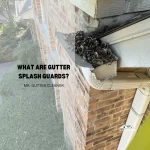Understanding the lifespan of a gutter system is crucial for maintaining a home’s structural integrity and preventing water damage.
A well-installed gutter system can last from 20 to 50 years, depending on the material—aluminum, vinyl, steel, or copper—and maintenance frequency.
Climate plays a significant role, as extreme weather conditions can accelerate wear.
Regular maintenance, including cleaning and inspections, can extend a gutter’s life by preventing blockages that cause water to overflow and damage the roof, walls, and foundation.
Homeowners should look for signs of sagging, rust, cracks, and separation from the house as indicators that the gutter system may need repair or replacement.
By addressing these issues promptly and choosing the right materials, homeowners can ensure their gutter systems protect their homes effectively for many years.
This introduction sets the stage for a deeper exploration of gutter systems, focusing on their longevity, the impact of various factors on their lifespan, and maintenance tips to maximize their effectiveness.
What Determines the Lifespan of a Gutter System?
The durability of a gutter system hinges on material choice, climate impact, and installation quality. These factors collectively dictate how long the system will function effectively without needing replacement.
Material Types and Their Durabilities
Gutter systems come in various materials, each offering different lifespans. Aluminum gutters, known for their resistance to rust, typically last up to 20 years. Vinyl gutters, while affordable and easy to install, may have a shorter lifespan due to susceptibility to cracking in extreme temperatures. Copper and steel gutters offer longevity, with copper lasting over 50 years and steel around 20 to 30 years, thanks to their durability against weather conditions.
Table of Contents:
- What Determines the Lifespan of a Gutter System?
- How Do Different Materials Affect Gutter Lifespan?
- Signs Your Gutter System Needs Replacement
- Maximizing the Lifespan of Your Gutters
- Gutter System Upgrades and Innovations
- The Role of Gutters in Home Maintenance
- Frequently Asked Questions About Gutter Longevity
The Impact of Climate on Gutter Wear and Tear
Climate significantly affects gutter longevity. In areas with heavy rainfall, snow, or extreme temperatures, gutters are subjected to more stress, potentially reducing their lifespan. Properly installed gutters in such climates need to be robust enough to withstand these conditions to prevent frequent replacements.
Installation Quality and Its Role in Longevity
The quality of gutter installation directly influences its durability. Properly installed gutters ensure optimal water flow and reduce the risk of sagging and detachment. Hiring experienced professionals for installation can prevent common issues that lead to early system failure.
How Do Different Materials Affect Gutter Lifespan?
The material of the gutter system is a crucial factor in its overall longevity, affecting its maintenance needs and resistance to environmental factors.
Aluminum Gutters: Pros and Cons
Aluminum gutters are lightweight, resistant to corrosion, and can last up to 20 years. However, they may dent or bend under heavy impact, requiring occasional maintenance to ensure proper function.
Vinyl Gutters: Advantages and Limitations
Vinyl gutters offer ease of installation and are immune to rust. Yet, their lifespan is typically shorter, around 10 to 15 years, as they are prone to damage from UV rays and cold weather, which can lead to cracking and brittleness.
Copper and Steel Gutters: Durability and Aesthetics
Copper and steel gutters are valued for their durability and aesthetic appeal. Copper gutters can last over 50 years, developing a patina that can enhance the home’s appearance. Steel gutters are sturdy and can withstand severe weather, lasting 20 to 30 years, but they require maintenance to prevent rust.
Signs Your Gutter System Needs Replacement
Identifying the right time to replace a gutter system is key to maintaining a home’s structural integrity. Certain signs indicate when a system is beyond repair and requires replacement.
Visible Damage and What It Indicates
Visible damage such as cracks, holes, or sagging sections signals that a gutter system is failing.
These damages can lead to water leakage, potentially causing harm to the home’s foundation and landscaping. Immediate action is necessary to prevent further damage.
Performance Issues and Water Damage
Performance issues, including persistent clogs and water overflow, suggest that a gutter system is not functioning as intended.
Overflowing water can lead to basement flooding and soil erosion around the house.
When these issues become recurrent, it may be more cost-effective to replace the system rather than repair it.
When Repairs Are No Longer Cost-Effective
Continual repairs can become expensive over time. If the cost of fixing the gutter system approaches or exceeds the price of a new installation, replacement is the recommended option. Upgrading to a more durable material can also enhance the home’s value and curb appeal.
Maximizing the Lifespan of Your Gutters
Extending the lifespan of gutter systems involves regular maintenance, professional inspections, and taking preventative measures against potential damage.
Regular Maintenance and Cleaning Schedules
Maintaining a regular cleaning schedule prevents debris accumulation, ensuring water flows freely through the gutters. Cleaning the gutters at least twice a year, usually in the spring and fall, can significantly reduce the risk of clogs and leaks.
The Importance of Professional Inspection
Annual inspections by professionals can identify minor issues before they escalate into significant problems. Experts can spot signs of wear, rust, and detachment, advising on whether repairs or replacement are necessary to maintain the system’s integrity.
Preventative Measures for Gutter Longevity
Installing gutter guards can minimize debris accumulation, reducing maintenance needs and extending the system’s lifespan. Additionally, ensuring proper water diversion away from the home’s foundation is crucial. This can be achieved by extending downspouts at least 5 feet from the house.
Gutter System Upgrades and Innovations
Advancements in gutter system design and technology have significantly contributed to extending the lifespan of gutter systems while reducing maintenance needs.
Gutter Guards: Do They Extend Lifespan?
Gutter guards play a pivotal role in extending the lifespan of gutter systems by preventing debris accumulation, which is a primary cause of clogs and water damage.
By keeping leaves, twigs, and other debris out, gutter guards ensure that water flows freely, reducing the need for frequent cleanings and the risk of rust and corrosion.
The Shift Towards Seamless Gutter Systems
Seamless gutter systems offer a significant improvement over traditional segmented gutters.
With fewer joints, seamless gutters are less likely to leak or detach from the home, thereby reducing the potential for water damage and extending the overall lifespan of the gutter system.
New Materials and Technologies in Gutter Design
Innovation in materials and design, such as the use of more durable materials like copper and coated aluminum, has led to gutter systems that are not only more effective but also longer-lasting. These materials resist weathering and corrosion better than traditional materials, offering homeowners a more permanent solution to gutter maintenance.
The Role of Gutters in Home Maintenance
Gutters are an integral part of a home’s exterior, playing a critical role in protecting the structure from water damage.
How Gutters Protect Your Home from Water Damage
Gutters direct rainwater away from the foundation, walls, and landscaping, preventing water infiltration that can lead to mold, rot, and foundation damage. Properly functioning gutters are essential for maintaining the structural integrity of a home and preventing costly repairs.
The Consequences of Neglecting Gutter Maintenance
Neglecting gutter maintenance can lead to severe consequences, including foundation problems, basement flooding, and damage to the home’s exterior. Regular cleaning and maintenance are crucial to prevent these issues and ensure the gutter system performs its protective role effectively.
Integrating Gutters with Your Home’s Drainage System
Integrating gutters with the home’s drainage system is vital for effective water management. This includes ensuring downspouts direct water away from the foundation and considering the installation of underground drainage solutions where necessary to prevent water accumulation and protect the home’s foundation and landscaping.
Frequently Asked Questions About Gutter Longevity
Homeowners often have questions regarding the maintenance and replacement of their gutter systems.
How Often Should Gutters Be Replaced?
The frequency of gutter replacement depends on the material, climate, and maintenance practices. On average, aluminum gutters need replacement every 20 years, while copper gutters can last over 50 years with proper care.
Can DIY Gutter Installation Affect Lifespan?
DIY gutter installation can affect the system’s lifespan if not done correctly. Professional installation ensures that gutters are properly aligned, secured, and sealed, reducing the likelihood of future problems that could shorten the system’s lifespan.
What Are the Signs of a Failing Gutter System?
Signs of a failing gutter system include visible sagging, rust, leaks, and water damage to the home’s exterior. Addressing these signs promptly can prevent more significant issues and extend the life of the gutter system.


